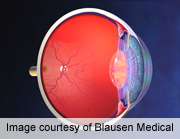People with age-related eye disease such as cataracts or glaucoma are less likely to see an eye care provider if they are in a low socioeconomic position, according to research published online July 18 in JAMA Ophthalmology.
(HealthDay)—People with age-related eye disease such as cataracts or glaucoma are less likely to see an eye care provider if they are in a low socioeconomic position, according to research published online July 18 in JAMA Ophthalmology.
Xinzhi Zhang, M.D., Ph.D., from the National Institutes of Health in Bethesda, Md., and colleagues analyzed data from individuals in the United States at least 40 years old with self-reported age-related eye disease to examine the association between socioeconomic position and use of eye care services. Data from the National Health Interview Survey were analyzed from 2002 (3,586 individuals) and 2008 (3,104 individuals).
Using the poverty-income ratio, the researchers found that after adjusting for other factors, those with a ratio less than 1.50 were significantly less likely than those with a ratio of at least 5 to report visiting an eye care provider (62.7 versus 80.1 percent) or report undergoing a dilated eye examination in the past year (64.3 versus 80.4 percent). Those with less than a high school education were also significantly less likely than those with a college education to report either activity. The slope index of inequality in both 2002 and 2008 showed significant differences for eye care provider visits across educational levels and additionally in poverty-income ratio in 2008.
"Significant differences in the use of eye care services by socioeconomic position persist among U.S. adults with eye diseases," Zhang and colleagues conclude.
More information:
Abstract
Full Text (subscription or payment may be required)
Journal information: JAMA Ophthalmology
Health News Copyright © 2013 HealthDay. All rights reserved.





















